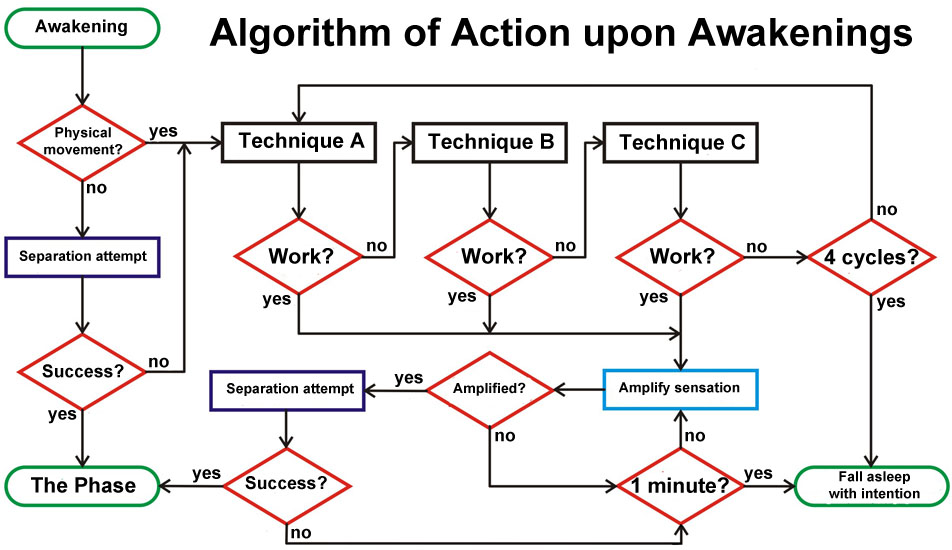My advice is to remind yourself that none of it is real and take those strange sensations as an indication that you are in the phase. Then, amplify them and separate. I can give you an overview of what "The Phase - A Practical Guidebook" advocates to enter the phase using shortcuts if you like.
First and foremost, sleep for a good few hours - six hours is reasonable. This is more effective if combined with the deferred, whereby the practitioner gets up from sleep and remains awake and active for a period of time (half an hour is decent) before going back to sleep with a strong intention to catch the next awakening in order to enter the phase.
Upon awakening, if there is no physical movement, attempt to separate from the body immediately. Movement will feel real but chances are that you have not moved physically. Rather, movement was simulated in the phase using your phantom body. If your separation attempt was successful, you should find yourself in the phase world. Yes, this is the one that really provides the shortcut.
If you manage to separate into the phase world upon an awakening you do away with fiddle-faddle. It can be that simple. Always attempt to separate from the body upon an awakening where you happen to not have moved physically. With this shortcut, you avoid having to employ techniques that make the transition into the phase long-winded.
But let's say the separation attempt fails you. Let's say you physically moved from the very beginning upon your awakening. In this case, start performing three types of techniques that encourage the emergence of sensations in your mind. Make sure each technique differs from one another in that each of them is specific in the kind of sensation they might produce. For example, technique "A" is for visualisation; technique "B" is for listening in; and technique "C" is for phantom wiggling (wiggling a part of the dream body).
Cycle through these techniques in succession, spending only a minimum of five seconds on each and not much longer than this. If after four cycles of these techniques no sensations arise (such as images, sounds, vibrations etc.), fall asleep with intention.
At the next awakening, you can attempt separation if there is no physical movement, and, if that fails, proceed to cycling through indirect techniques once again. If one of the techniques yields results, focus on it and forget the others. Persist with the one that happens to be working and start to amplify whatever sensation has arisen - this could be anything from strange images, sounds, vibrations, or even the involuntary movement of a part of the phantom body. Once you have succeeded in amplifying the sensation, try to leave the body again. If successful, you're in a fully fledged phase state.
If not, ask yourself if a minute has passed. If it has, fall asleep with intention in order to yet again catch the next awakening. Who knows, because of this exercise, you may even find yourself fully conscious in a dream, in which case there is no need to wake up in order to separate because you are already in the phase. If you think a minute isn't up yet, go back to amplifying the sensation. If you can't amplify it, ask yourself if a minute is up (again). If it is, fall asleep, catch the next awakening, and follow the same procedure.
The other method is the "direct" one which is harder and requires no prior sleep. It's achievable but the novice should master the indirect one first. The direct method is essentially the same as the indirect one but minutes, rather than seconds, are spent on each technique as you cycle through them. This is a requirement due to different physiological and psychological conditions in which this method is performed. Once again, the novice should avoid the direct method. Like the indirect method, this more challenging version of the application of techniques is more effective if deferred.
If a practitioner manages to enter the phase within 5 minutes of an awakening, after having moved, then he has not breached the indirect method. If the individual is up for longer than 5 minutes, however, and then returns to bed and succeeds in inducing the phase state, he has succeeded in doing so directly. Both variations may lead to dream consciousness after falling asleep with intention. This is what is commonly referred to as dream-initiated lucid dreaming.
SEPARATION TECHNIQUES
There are various ways of doing this such as getting up, levitation, spinning, climbing a rope, sinking into the bed, or even swimming away from the perceived physical stencil. I tend to just get out of bed these days. Sometimes I float out. But when I was a beginner, I found that the 'rolling over and out' technique particularly facilitating. This can be done without tensing muscles. In my case, I found that it was easier to start from the head as I found that the rest of the perceived body tends to easily follow the turning motion. If you are touched, or poked in some way, fear not. Grab whatever hand touches you and use it to climb out of the body.
Now, the diagram to make it easier to understand what I have just stated above:

What you want is the shortcut that goes straight from "awakening" to "The Phase". You want to avoid the cycling through techniques part. That should only be done lest separation upon awakening fails.






